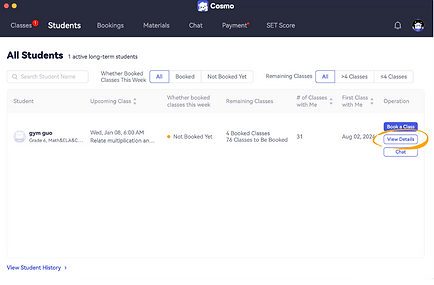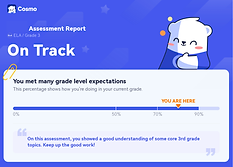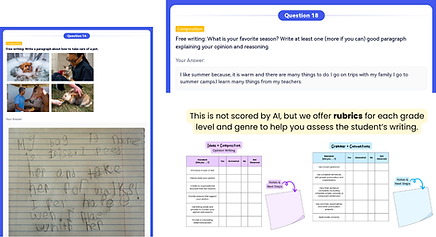ELA Assessment Report

Who takes an assessment, and who assigns it?
When a student signs up for a trial class, an educational consultant (meaning a member of the sales team) sends the applicable assessment.
Students are encouraged to complete the assessment before their trial class, but it's not required for them to join.
When the assessment is sent, we also recommend that parents do not offer help or let their student use outside resources like a dictionary or ChatGPT. Our aim is to gather the most accurate data we can, but as you know, it's impossible to fully control this in a virtual setting.
For long-term students who need to take an assessment, you can request that your learning partner send it via chat.


What is on the assessment?
The assessment is adaptive, so the questions at and within each grade level vary slightly. In general, there are both literature-based passages like an excerpt from a children's novel, an original story, or a poem) and informational text passages, each with a set of multiple-choice questions assessing a variety of reading and language skills. At the K-2 level, you'll also see some questions assessing phonics. The final question contains a writing prompt where students can type or upload an image of their response.

When do students take the assessment?
Ideally, students take the initial assessment before their trial class. If you're working with a long-term student and suggest they take (or retake) a grade-level assessment, you can ask your learning partner to send it their way any time. Cosmo AI also sends students smaller check-in assessments after every four classes to help you monitor progress, but in this video, we're focusing on the initial assessment report.
Where do I find an assessment report?
If a student completes their assessment before their trial class, the assessment report will automatically upload as a class material.
You'll receive a message from the Cosmo bot in your teacher app letting you know a student has completed their assessment, as well as a link to their results. This will also be sent as an email notification to the email you provided during your Cosmo onboarding.
For your long-term students, you can go to your "students" tab of the Cosmo teacher app.
Click "view details" to open up a student's profile. Click "assessment" across the top. You'll see all their assessment reports here.


Why do students take an assessment?
We realize that students take a lot of tests at school, but good data is really important for high-quality instruction. Our goal is to collect as much information about the student's needs as possible so you can meet them where they are.
We've tried to create an assessment that's not too long for a kid to sit through but still gives us enough information to create a personalized learning plan.

How do students take the assessment?
Right in the app! Students receive a message from their educational consultant with a link to the correct grade-level assessment. They will need to be on a tablet or computer to complete it - there is a Cosmo student phone app, but the assessment will not load on mobile.
Because it's computer-based, the multiple-choice questions are scored right away, and students can immediately see their results.Remember, students aren't required to take the assessments that are sent, so if you're not seeing results, they likely haven't completed it.
There are four levels a student can be assigned based on their score.




If they score below 50%, they have "room for improvement." These students have not met grade-level expectations.
If they score between 50 and 70%, they are "getting there." They've met some grade-level expectations but are not considered on grade-level yet.
If they score between 70 and 90%, they are considered on track, meaning they're at grade level.
If they score above 90%, they are excelling. They've met the grade-level expectations on their assessment and may be ready to work on content above their grade level.
You'll notice that Cosmo is doing something different at each level, and you'll see a slightly different message in quotation marks depending on their score.
Page 2:
Depending on their score for each domain, students may be considered emerging, developing, or proficient. The bullet points share some areas for improvement based on how the student answered their assessment questions.
The writing section has a standardized note indicating that you will review their writing sample during the trial lesson. You'll see this on the final page of the assessment report. Keep in mind that these aren't exhaustive lists! Parents/students may have additional goals to add in the next section, the PLP.
There are four domains for K-2 students: reading, phonics, language/grammar, and writing.
Starting in third grade, there are only three domains (reading, language/grammar, and writing) - phonics stops at grade 2.

Page 3:
The third page outlines the personalized learning plan, or the PLP. This is generated by Cosmo AI based upon the student's assessment results. This note at the top will vary slightly based on the student’s assessment score.
For example, this student struggled more on third-grade topics, whereas this student is ready for a bit more of a challenge.


As a student works through the skills listed here, Cosmo AI will continue to update the PLP. But also know that as the teacher, you can edit and customize a student's PLP at any time. Check out the videos on "Understanding the PLP" and "How to Edit a Student's PLP" for more info.
You can also see what domain a skill is housed under, whether the skill was on the assessment, and the general difficulty of the skill and associated lesson. This is all designed to give you information about how to best approach your work with each student, not to be hard and fast rules to follow.
Page 4:
The final pages show the assessment questions with both the student's answers and the correct answers.
For a quick visual cue, a student's correct answers are highlighted in green with a check mark, while incorrect answers are red with an X. The correct answer for each question is also indicated underneath.


No matter the grade level, the very last question on the assessment contains a writing prompt. Students may type their response or upload an image.
This is not scored by AI, but we offer rubrics for each grade level and genre to help you assess the student’s writing. Check out the video on how to use an assessment report during a trial class as well as the video all about our writing rubrics to learn more.